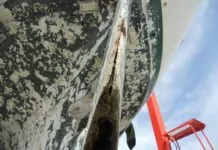
There isn’t much that scares or worries me when it comes to all things about boats. Except two: large amounts of water coming in and, the scariest of all, the smell of a propane or fuel leak.
Fortunately, on my boat I use diesel, so besides being a smelly mess to clean up, a diesel fuel leak isn’t really scary. But I do have a propane system that can be a much more serious and dangerous situation to deal with given a leak.
Luckily, because propane itself has no smell, manufacturers add additives that make it smell terrible in order to alert of a leak. This smell is most often referred to as rotten eggs. So, if you have propane and ever smell that very distinctive smell, pay immediate attention by closing the propane tank valve as soon as possible, open all windows, hatches and doors to ventilate. Make sure everyone onboard is aware and refrain from smoking or doing anything that can cause a spark.
Also, despite its distinctive smell, be aware that since propane is heavier that air, it will gather in the deepest areas of the boat first. So by the time you smell it (at your nose level) chances are the bilge and lower areas of the boat are already full of propane fumes. Once you do smell it, immediate action is needed. Opening any and all floor boards and bilge access while ventilating is highly advisable.
Once the odor has subsided, do leave everything open for a few hours or as long as possible.
Now, you can safely start the task of detecting where the leak is and fixing it.
FINDING THE PROPANE LEAK
To do so, you will need a few basic tools. As propane fittings are pretty much standardized, you will need a 3/4-in., 11/16-in. and 7/16-in. wrench, one or two medium size Wescott wrenches, a roll of Teflon tape and a spray bottle with soapy water.

Start from the propane tank and locker itself as this is the most common area for leaks at fittings. Start with removing and inspecting the tank. In my case, I had my tank recertified earlier this year. Even though I was confident the tank was not the issue, I still removed it and opened the valve to make sure it was not faulty. If it is the tank, have it serviced and recertified. If is it not the problem, reinstall the tank and proceed with the next steps.
Open the propane tank valve. Assuming you also have a pressure gauge (if not, I would definitely get one), you should see it rise and indicate the pressure. Now, close the valve and watch the gauge. If it goes back down, this will confirm there is a leak.

Open the valve once more. If the smell starts almost immediately, you will know the leak is indeed nearby. Using the soapy water spray bottle, spray all the joints and fittings. Since propane is under pressure, any leak should reveal itself by making bubbles. If you spot a leak, keep spraying as there may be more than one leak and don’t forget to look under each fitting as well, where a leak might not be visible from above. Use a small mirror or your smart phone camera to inspect hard to see areas (my leak was under a fitting and I could not see it until I was resealing each fitting).
FIXING THE PROPANE LEAK
The most common leak areas are at the fittings. So following my philosophy of maintenance costs less than repairs, I would recommend removing, cleaning and replacing the Teflon tape on all the joints. If one failed, chances are the others may not be long in leaking themselves. Besides, it’s an easy fix and while you have all the tools out, why not?
Once you’ve reset all the fittings and stopped the leak, you’ll feel relieved in the knowledge that all the fittings are now safe and will be for a long time!




































The pressure gage in the tank is does not indicate how much propane is left in the tank, instead it’s a safety device. Open the tank valve, note the pressure, close the tank and see if the pressure falls after a few minutes. If it does, you have a leak. If the solenoid is off (closed) and the pressure drops, the problem is in the propane locker. If it holds with the solenoid off, but falls falls with the solenoid on (open), the problem is in the interior piping, stove hose or appliance (stove), assuming all the burners are off. More dangerous.
Teflon tape for gas work is yellow. It’s a little thicker than white.
I thought I knew tools from my 72 years of using them, but I’ve never heard of a “Wescott” wrench. I had to look it up. It’s an adjustable wrench – the wrench at the top of his tool photo.
Although it appears that true Wescott wrenches are antiques with a distinctive curved handle, You can learn something every day if you’re not careful.